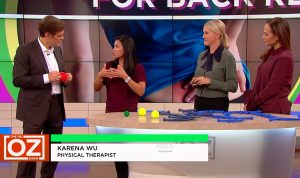 ActiveCare Physical Therapy, PC
ActiveCare Physical Therapy, PC
29 West 38th Street
Suite 601
New York, NY 10018

Disc Herniations with Leg Pain (Radiculopathy): Understanding, Treatment, and Recovery
 Disc herniations, often accompanied by leg pain known as radiculopathy, can be a debilitating condition that affects your daily life. When a spinal disc bulges or ruptures, it can compress nearby nerves, leading to pain, weakness, and numbness in the legs. In this post, we’ll explore the causes and symptoms of disc herniations with radiculopathy, treatment options, and the path to recovery.
Disc herniations, often accompanied by leg pain known as radiculopathy, can be a debilitating condition that affects your daily life. When a spinal disc bulges or ruptures, it can compress nearby nerves, leading to pain, weakness, and numbness in the legs. In this post, we’ll explore the causes and symptoms of disc herniations with radiculopathy, treatment options, and the path to recovery.
Understanding Disc Herniations and Radiculopathy
A disc herniation occurs when the soft inner core of a spinal disc protrudes through the tough outer layer. This can happen due to:
1. Age-Related Changes
As we age, spinal discs naturally degenerate and become more prone to herniation.
2. Injury or Trauma
An injury or trauma to the spine can cause disc herniations.
3. Repetitive Strain
Repetitive lifting, bending, or twisting motions can contribute to disc herniations.
Radiculopathy, on the other hand, refers to the pain, numbness, and weakness that radiates along the path of a compressed nerve root. When a herniated disc presses against a nerve, it can lead to these symptoms in the legs.
Symptoms of Disc Herniations with Radiculopathy
Common symptoms of disc herniations with radiculopathy include:
- Sharp or burning leg pain.
- Numbness or tingling in the legs or feet.
- Muscle weakness in the legs.
- Difficulty walking or standing for extended periods.
- Loss of bladder or bowel control (rare, but serious, and requires immediate medical attention).
Treatment Options
Effective treatment for disc herniations with radiculopathy often involves a combination of conservative and, in some cases, surgical approaches:
1. Physical Therapy
Physical therapy plays a crucial role in reducing pain and improving mobility. Therapists can provide exercises, manual therapy, and techniques to relieve nerve compression and strengthen the back and core muscles.
2. Medications
Nonsteroidal anti-inflammatory drugs (NSAIDs) or muscle relaxants can help manage pain and inflammation.
3. Epidural Steroid Injections
In some cases, corticosteroid injections into the affected area can provide temporary relief from pain and inflammation.
4. Surgery
Surgery may be considered if conservative treatments are ineffective, or if there are severe symptoms like loss of bladder or bowel control. Procedures such as discectomy or spinal fusion may be performed to alleviate nerve compression.
Recovery and Rehabilitation
Recovery from disc herniations with radiculopathy may vary depending on the severity of the condition and the chosen treatment approach. Physical therapy is a crucial component of rehabilitation and recovery, helping patients regain strength, flexibility, and function.
1. Pain Management
Physical therapists can employ various pain management techniques to alleviate discomfort and improve mobility.
2. Muscle Strengthening
Specific exercises are designed to strengthen the muscles that support the spine and alleviate pressure on the nerves.
3. Education
Patients receive guidance on proper body mechanics, posture, and lifestyle modifications to prevent future issues.
4. Gradual Return to Activity
Physical therapists work with patients to gradually reintroduce physical activities and daily tasks while monitoring progress.
Disc Herniations with Leg Pain: Conclusion
Disc herniations with leg pain (radiculopathy) can be challenging, but with the right treatment and rehabilitation, many individuals can find relief and regain their quality of life.
If you’re experiencing symptoms of disc herniation or radiculopathy, it’s essential to seek prompt evaluation and treatment from a healthcare professional or physical therapist, such as those at ActiveCare Physical Therapy™ in New York City.
